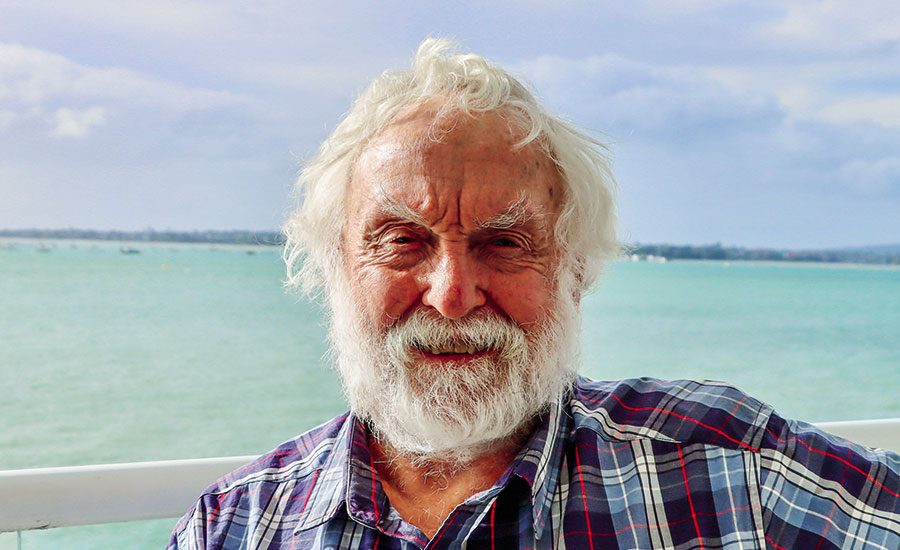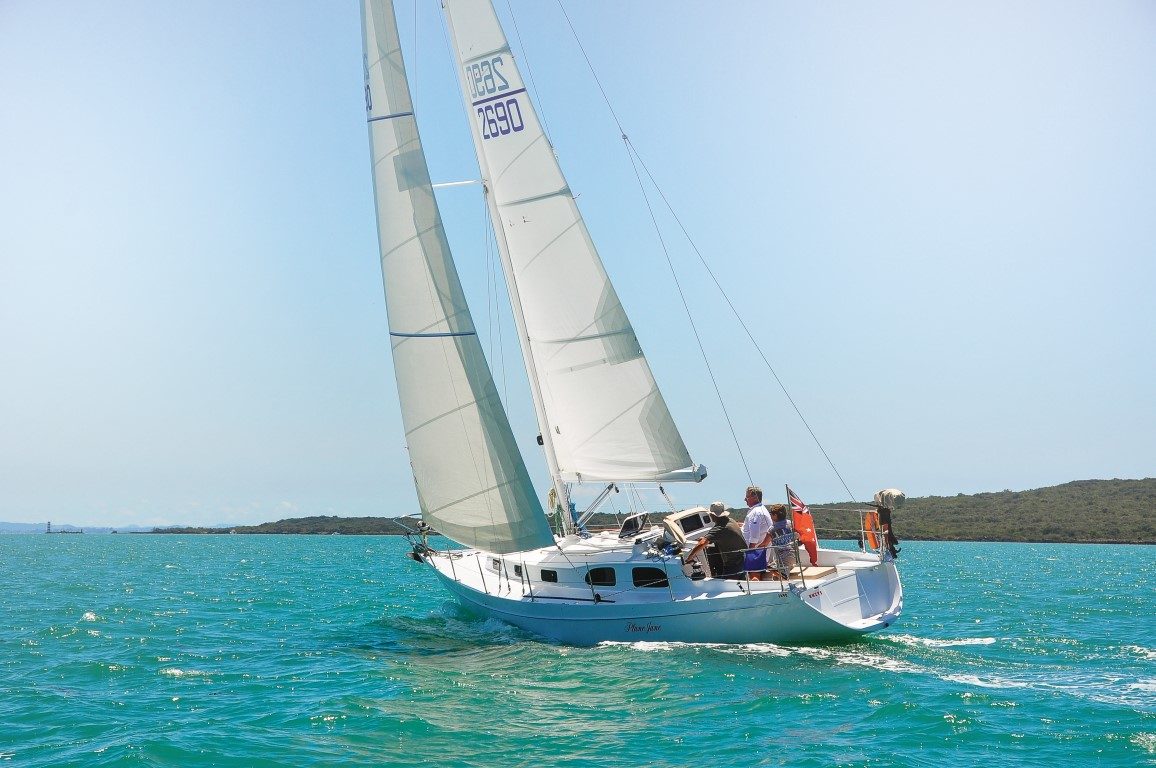

Although Tim Porter’s been involved with Boating New Zealand for 30 years, he’s stayed out of the magazine until now. It took some arm-twisting and gentle threats before we managed to get him to sit still long enough to tell his story.
“I was born in Pakuranga [Auckland], the youngest of three brothers, but honestly, I think I was a bit of a mistake.”
Mistake or not, after Tim’s dad moved out, his mother, Doreen, had no choice but to bring up her youngest son solo. Tim’s introduction to boats came early on when Doreen bought a Sea Nymph 14.6 runabout, which she towed behind her Holden Torana. Although Tim didn’t realise it then, cars and boats would be two constants in his life.
At age 15, Tim became passionate about windsurfing and owned several, including a Comet, a Mistral and a Superstar.
“I bet most people will be surprised to think of my interest in yachts. I was never very interested in fishing.” [Editor’s note: tut tut…]
After gaining his UE, Tim began an accountancy course at Manukau Polytech.
“It wasn’t me, so I left after six months and got an administration role at Wrightcars.”
Wrightcars was the motoring division of Wright Stephenson & Co., and with over 30 branches, and was then the largest Toyota dealership in New Zealand. Despite being one of their youngest salesmen, Tim proved very successful and, within two years, had saved enough money to buy a new Sea Ray 180 bowrider from Sports Marine.
“The American boats were just coming into the country.
I was tossing up between the Sea Ray and a Sea Nymph Hustler. I bought the Sea Ray. It had a 135hp Mercruiser, nicely colour-matched, something that hadn’t been seen in New Zealand.”

After four years with Wrightcars, Tim joined the late Peter Bell at Sports Marine, but that didn’t work out, so a year later, he got into selling newspaper advertising. He then met Bruce Laybourn, who, with Mal Taylor, had founded Boating New Zealand in 1986. Recognising his qualities, Laybourn recruited Tim.
“Tim joined Boating New Zealand in the crazy 90s as part of the sales team. He was comfortable right from his first day and had found his happy place. No surprise he’s never left,” says Laybourn.
Around 1996, Taylor sold his share of Boating New Zealand to Independent Newspapers Ltd (INL), and three years later, Laybourn followed suit.
Boating New Zealand became part of INL’s magazine portfolio. Tim shifted to Four Wheel Drive magazine but later returned to Boating New Zealand as Magazine Manager. Around 1998, Tim, Barry Thompson, and Peter Busfield, CEO of the NZ Marine Industry Association (NZMIA), founded the On-the-Water Boat Show in the Viaduct Harbour, an outstanding success.
Like many in the industry, Busfield holds Tim in high regard,
“Tim’s always been an aspirational thinker, very supportive of the industry in a wider context. He’s been a huge advocate for the industry and, through the magazine, sponsored boat shows and the NZMIA Conference.”
At INL, the late Maggie Maxwell first got Tim thinking like a manager. “Maggie was very much my mentor,” confirmed Tim. Around 2003, INL sold all its newspapers and magazines to Fairfax Media.

Between 2003 and 2011, Tim served as General Manager of Specialist Magazines. Besides Boating New Zealand, he oversaw New Zealand Autocar, New Zealand Fishing News, Fish and Game NZ, Lifestyle Block, New Zealand Horse and Pony, Ponies, New Zealand Trucking and The Cut.
As these were all specialist publications, Tim realised the importance of having the right editor for each title. Independently, he kept a finger on the pulse of each magazine’s readers and advertisers. He also keeps a close tab on key players in the industry to check how the magazines are being perceived.
One of these players is Lionel Sands, who only recently retired from the day-to-day management of Haines Hunter Boats.
“The thing I most value with Tim is his integrity; he’s always got your back and is there if needed. I enjoy his humour; it’s always a pleasure when he drops in.”
Another is Greg Fenwick, ex-General Manager of Yamaha Marine: “One thing that’s always impressed me is Tim’s patience at going to After-Five functions. That takes a lot of organising and travel, but Tim realises the importance of being part of the industry.”
Then there’s Griff Simpson of Fi-Glass Boats.
“I’ve always enjoyed Tim’s take on the industry and to give straight up, honest advice on advertising even when there’s nothing in it for him. It has been interesting to see him develop within the industry from the early days when it was all print to nowadays with all the multi-media stuff.”
A long-time client of Tim’s is Blair Geldard, Director of Advance Trident Ltd.
“The relationship with Tim began with my father [the late Trevor Geldard]. Tim is passionate about the industry and his customers. He’s a good networker and ensures he’s at every function because he knows it’s the right thing for the magazine.”
Lance Fink of Tristram Marine couldn’t speak highly enough of Tim, “If I wanted another brother, I’d choose Tim. He’s a gentle giant, one of the industry’s gentlemen.
I have huge respect for him.”

In 2011, Tim resigned from Fairfax’s magazine division and, with his then-wife Ursula and two children, Jack and Greer, moved to Wanaka for a better lifestyle. Fairfax didn’t want to lose him and created the role of Regional Manager for their Southland newspapers whilst he continued managing Boating New Zealand part-time.
His link with the magazine proved fortuitous because, in 2016, Fairfax sold off most of its magazines. Boating New Zealand was offered to Tim, and he asked then-advertising manager Brett Patterson to join him as co-owner. Knowing his track record, Patterson didn’t hesitate.
“Tim’s an incredibly talented publisher. He has this natural instinct and perception around publishing, audiences, and what they want. When we were making decisions about going into business, there was no one I wanted to go into business with apart from Tim. I wouldn’t have done it otherwise.”
Since 2016, as the publisher, Tim has guided the magazine through the ups and downs of the print world. Under its corporate ownership, there was a tendency to cut costs, which Tim believes is a race to the bottom. He’s taken the opposite approach of aiming for higher-quality content and presentation.
“It’s a matter of having a great team around you: Editor, writers, photographers, art directors and print manager. You have to trust and back your people. As a publisher, you don’t want to get too involved; the magazine’s far bigger than one person.”

That’s easier than it might have been, as most of the Boating New Zealand team have been with the magazine for years and, in many cases, decades.
Boating New Zealand’s Production Manager, Mike Embleton, who started with the magazine a few months before Tim, has been on the team for 30 years,
“Even in the beginning, Tim had a bigger vision and could see the potential. His instincts were good; he knew which advertisers to call on. He’s canny; I’ve often seen his predictions come true. He’s also very likeable, an easy bloke to work with; he leaves you alone to do your thing and only interferes if you do something ridiculous.”
Lawrence Schaffler, the magazine’s editor between 2015 and 2021, and a regular contributor: “I’ve always been impressed by Tim’s unfailingly upbeat view of the world. He never seems to get despondent and approaches life’s curve balls with philosophical good humour. Valuable traits in the publishing world.”
Schaffler’s thoughts are echoed by regular contributor Sarah Ell, another ex-Editor of Boating New Zealand, who has also known Tim for 30 years,
“Tim’s one of the most exciting, enthusiastic people I know. He’s genuinely passionate about the boating industry and good at building relationships. And he’s stayed current despite the huge changes over the past 30 years.”

Current Editor John Eichelsheim has worked off and on with Tim for 20 years. “Tim’s definitely a magazine person; he has a strong vision of what will and won’t work. I’ve particularly admired his ability to work with different people and remain friends with them even years later.”
The team stepped up when Covid hit, especially during the first lockdown between March and May 2020. With everyone confined to their houses, publishing a magazine was an immense challenge. However, Tim felt that those trapped at home would be looking for something read, an escape, and despite losing money, Boating New Zealand published throughout the lockdowns. That was a gutsy call.
In summary, while Tim has never set the world on fire academically, his attitudes have more than compensated.
Loyal? Passionate? Yes, and again yes. Competitive? You bet. Canny? Absolutely. Finger on the pulse? Yep, that too. A born networker? In spades. A great salesman? Watch yourself; he’s lethal. Empathetic and caring? Affirmative. An ability to recruit the right people? Unquestionably. There when needed, out of the way when not? For sure. Tim Porter, magazine publisher, this is your life. So far…
Roasting Tim Porter
No story of Tim is complete without detailing a few of his transgressions. Not all of his bright ideas have shone that brightly; some of them have had painful consequences.
Ell recalls one, “I remember when he had this idea of riding a jet-ski from the Coromandel, around Cape Coville and down to Whitianga. It was snarly weather, and while they finished the trip, he couldn’t sit down for a week.”

Laybourn shared a similar story. Tim challenged him to enter the 160-kilometre Round-Taupo bike race, promising to beat him by half an hour. The canny Layborn accepted Tim’s challenge and began secretly training.
“We duly entered a Boating New Zealand team, the magazine logo and ‘Seamen on the Lake’ emblazoned across our Lycra gear. I lost Tim on the climb to the lookout above Turangi and presumed he had charged ahead. I crossed the line, and eventually, Tim came into view. His prediction about a 30-minute time difference was correct, but I – the old bugger – finished first.”
Despite its best efforts, no publication gets it right every time, and Tim has to front up to accept the flak. Geldard recalls one case,
“There was an issue with one of our advertisements, and Tim fronted up wearing a hard hat and carrying a baseball bat for protection from the ear bashing he knew he was going to receive. We got a few free ads out of that one.”
Fink recalls when a hard hat would have been helpful when Tim was driving a Tristram boat,
“Tim was driving like a maniac. We came off a wave, and I cracked my head on the windscreen. I spent the rest of the day holding a towel to my eyebrow. I see that scar every day in the mirror.”

Tim’s no stranger to after-match functions and, as Schaffler found out, has a well-developed reputation for holding his own at the bar,
“I once tried to match his ability to drink beer, jug-for-jug. I would have conceded defeat early in the contest had I been able to.”
However, according to Simpson, Tim’s not quite the man he once was in this regard,
“Of course, he’s getting a bit soft these days. We were out the other night, and he said ‘no’ to another drink. He never used to do that.”
Besides a passion for boating, Tim is equally passionate about his appearance, including, as Patterson discovered, his hair,
“Tim’s got this magnificent, lush crop of hair, and he’s partial to a bit of gel. He’d be distraught if he’d left home on a road trip without gel. We couldn’t go to our next appointment until he’d been to a chemist to pick up some.”





